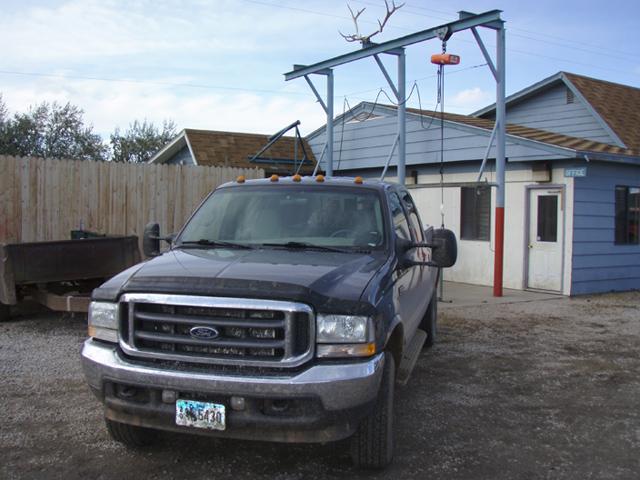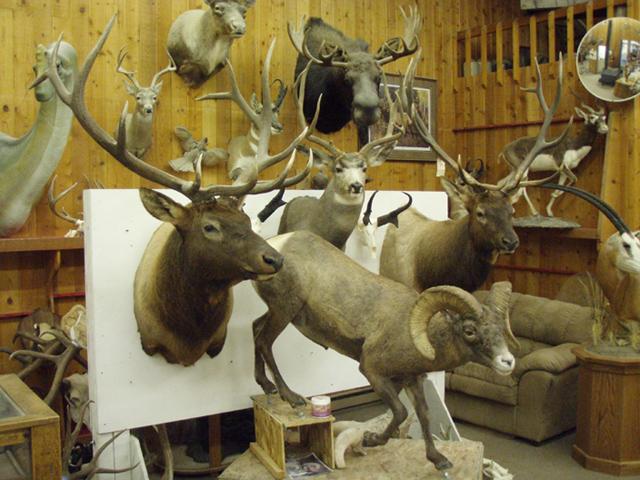5th October
Evening
At 2.00pm we drive to the nearby town of Sinclair.
Every pickup I've seen so far is a dwarf compared to Jeff's 10-cylinder Ford F-250. Cenni, not the owner, is in charge of the machine at present. In the back are the carcasses of two mule deer, their skulls, and the elk meat. We are heading to the local taxidermist's and the game meat processing factory.
You can find any meat product you want there, ready for consumption. They mainly offer sausages and other red-meat products. I don't buy anything; quite frankly, I don't have any more space, not even for sausages.
While the paperwork is being done, we look around the trophy room. It is here that they display all the uncollected antlers and horns. There are some that have been waiting here to be collected for ten years. The taxidermist says that the brave hunters sometimes forget all about their trophies. I can't imagine doing that. Someone comes here, pays a significant sum of money to bag an elk, and then goes home and forgets about the whole thing? As if he'd never been to Wyoming! Or does he say: I don't need that trophy, a photo will do just as well! One or two cases might be explained by the hunter dying; or having unexpected health problems, which make him forget his trophies.



Chapter VIII.: Deer Hunter
Page 34
But there are many hanging on the wall here. Maybe they feel they have outwitted the taxidermist, as his work will go unpaid. We see several interesting trophies, and one makes me burst out laughing. This miserable creature was once a mule deer, but the taxidermist working here in the 1930s did a very bad job on it. It is hanging there as an example of how not to do it. It has bulging eyes like ET, giving the whole head an idiotic, cartoon-like expression. It's hard to live without a sense of humor, and the owner here knows it. Among all the top-class work are modestly hanging two or three plastic dinosaur heads, bought for peanuts in local toyshops.



Chapter VIII.: Deer Hunter
Page 35
.I love these outings. I learn more about the everyday life of my guides and observe new things.
Why sit around in the tent when there are better things to do?
On our return, Cenni asks me if I feel like hunting coyote. I've been waiting for this moment.
Cenni is a good hunter, and if there is anyone who can teach me anything, it will be him. Hunting coyote is so different from anything I've ever done in Hungary, that this afternoon is bound to be a big adventure.
And I'm here to hunt, not to lounge about in a sleeping bag.
Let's take a look at what guns a professional takes with him to the hunting grounds.
Cenni has two, a shotgun - that one is for me - and a rifle. The shotgun is a Benelli, painted in camouflage colors, and Cenni has also asked me to wear my camouflage clothes. For this sort of hunting being difficult to see is very important. He thinks that the advantage of a Benelli over a Remington is that, when he has emptied the gun chamber, it will not automatically reload from the


Chapter VIII.: Deer Hunter
Page 36
magazine. Remingtons work in a different way. With them you have to do something special to stop them reloading automatically. There are days when you need to empty the gun chamber 20 -
30 times, so that little difference can be quite important.
The Benelli is a left-handed gun, which means that the cartridge case is ejected on the left side.
That is important because when shooting from a plane, Cenni has to sit on the left, and if he used a right-handed gun, the cartridge cases would be rolling around in the cockpit, possibly interfering with the pilot. The gun has a long magazine, which swallows up all the cartridges, one after the other. The first cartridge is 70mm long, filled with BB-sized lead shot. Cenni thinks it is effective up to 135ft. The others contain a smaller diameter steel shot filling, but are 76mm long. He says that for the wider diameter of the lead shot, 76mm is too long. It would travel too fast just after it is fired, and, as a first shot, would do too much damage to the skin. For steel shot ammunition, 76mm is the optimum length, and the spread is greater.
If the coyote is further than 135ft. and it is not possible to entice it any closer, Cenni will use his main work gun, a Remington 700, which has several modifications and alterations. He has painted the stainless steel barrel himself, in desert camouflage colors, and changed the original butt to a matt, sand-colored Kevlar one, made by H-S Precision. The ammunition is kept in a Blackhawk cartridge case, again in camouflage colors, which can be hooked to the butt; it also holds the coyote-caller too.
There is also a fork -shaped stand, which can be attached to the rifle. The Harris bipod, famous the world over, doesn't come up to Cenni's expectations. He thinks it is too heavy, and too complicated when being set for an ideal shooting height. And on a coyote hunt you have to get into your shooting position in seconds.
The barrel is a special caliber, specifically made for him. The ammunition is a non-standard caliber, known as wildcat. It is called this because it is not made by any manufacturer, so - when the law permits it - the hunter must make the entire thing, including the outer casing, himself, at home. In America, wildcat has been, and still is, very fashionable. Some home-made cartridges are so effective that large manufacturers have even started producing them themselves, which means that the wildcat then becomes standard ammunition. A good example of this is the 7mm -
08 Remington cartridge. The trouble with wildcat ammunition is that - as it isn't standard size - it is almost impossible to buy a ready-made gun already barrelled for it. So the shooter - or hunter -
must have a barrel made in a specialist workshop, thus increasing the price. Getting them made is not a problem here; there are countless workshops about, all making barrels.
According to Cenni the main advantage of home-made, reloadable ammunition is not that it has a faster muzzle speed than factory-made ammunition. If you need greater speed, you can buy a


Chapter VIII.: Deer Hunter
Page 37
gun designed for stronger and faster cartridges. Its real value is that the starting speed of each individual cartridge is almost always consistent. There's no point in discussing accuracy until you have established that the starting speed is always the same, as it is this factor that fundamentally determines the trajectory. Once, at the Keszthely rifle range, as an experiment, we measured the speed of a box of .308 Norma Oryx ammunition, and found, within that box, a variation of 15%.
We carried out the experiment using two separate measuring devices at the same time, so, though the possibility of error cannot be excluded, it is not very likely. For everyday hunting activities it shouldn't cause problems; for example in the case of a wild boar shot from 600ft. the killing effect is not much affected if the shot strikes 1/2 - 1 1/2ins higher or lower.
However, coyote hunting is different.
A shell that works well in other types of hunting could be useless in a varmint hunt. I should also mention that the Oryx is one of the most efficient cartridges on the market, and many consider that the Norma ammunition made for competitive purposes is the best in the world. I'm absolutely certain that Norma competition ammo does not have such a wide variation in muzzle speed. But, irrespective of all that, Cenni only trusts the cartridges that he has filled himself. With these the speed variation is a maximum of 2%.
On our hunt this evening, we will take Sam, the dog, along with us. She has got a bit lazy living in the camp, and is starting to forget that she is a hunting dog. It's time she got some exercise.
She will have two main tasks.
The first is that, with her excellent sense of smell, she will detect any coyote approaching our electronic bait, even if we can't see it because of all the undergrowth. The second will be for her to actually engage in a fight with the coyote. If the coyotes have cubs, and the dog gets too close, then, without a thought for themselves, the coyotes will attack her. It gives us a chance to shoot, though it is not without risks. When a coyote is fighting with a dog, it is not an easy target, and we must take care of Samy's safety. I haven't much experience using a shotgun, and just as I would not want to shoot at a fox being chased by a dog, I wouldn't dare to take a shot at a coyote if Samy is close by.
Our first cover is a gully, which we use as a trench. We lie on its gently sloping bank and look out over undergrowth from there. We don't need Samy at the moment so we leave her in Greeny.
She stares out, looking rather offended.
If a coyote gets close enough, I will shoot with the Benelli.
If it stays at a distance, Cenni will use the Remington.
We switch on the caller. Awful moans, groans, screams, death-rattles and howls fill the valley. We have to watch every direction, but it is essential we remain still. It is virtually just our eyes that we



Chapter VIII.: Deer Hunter
Page 38
can move. If a coyote comes near, then, shoot, shoot, shoot! Those are my instructions.
We listen attentively to the horrible noises roaring from the speaker.
Cenni points to the left behind us: here they come! There are three, but the wind is bad! Cenni turns with his gun, aims quickly... they stop... bang! One falls. Bang! That one runs away. We measure the distance with the laser: 1380ft., and there's a crosswind... I make no comment, but Cenni openly admits it: it was a very lucky shot. Because of the wind, he deliberately aimed one coyote-length wide, and made a hit. The second shot was just a simple failure. No more than that. He does not agonize over it.
We gather everything up, and set off in the jeep. We can only stay in the same place for a maximum of 20mins. If a coyote doesn't appear within that time, we must go somewhere else.
We try two more places before dusk, but they are failures, even with Samy's help.


Chapter VIII.: Deer Hunter
Page 39
Deer Hunt Camp


















